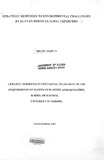| dc.contributor.author | Mburu, Mary N | |
| dc.date.accessioned | 2013-05-10T12:33:11Z | |
| dc.date.available | 2013-05-10T12:33:11Z | |
| dc.date.issued | 2007 | |
| dc.identifier.citation | Masters of business administration | en |
| dc.identifier.uri | http://erepository.uonbi.ac.ke:8080/xmlui/handle/123456789/21391 | |
| dc.description.abstract | Business organizations are open systems and therefore depend on the environment in
which they operate for success. It is therefore important for organizations to formulate
strategies that will help them exploit the opportunities in the environment and minimize
threats.
The horticultural industry has not been spared by the environmental changes. It is facing
many environmental challenges which include the flight miles campaign, Economic
Partnership Agreements (EPA's) that will result to new terms of exports for the Kenyan
horticultural export companies which will have to comply with a new range of
conditions, to be able to trade and compete effectively in the EU market. Others are
increased competition especially from China and changing weather patterns making
supply of products to the market all year round a challenge to most organizations.
The objective of this study was to establish the strategic responses that the horticultural
companies have adopted in the face of current environmental challenges. The target
population was firms registered under Fresh Produce Exporters Association of Kenya
(FPEAK). A sample of 20 companies was randomly drawn.
The main findings were that the changes had a very adverse impact. On analysis of
specific challenges, the following was evident. Change of tariffs was ranked as the
challenge that posed the highest impact in the industry. Competition followed with the
majority of the organizations reporting the change to pose a high impact. Climate change
VI
was ranked third with most organizations reporting the impact as fair. Air miles was
reported as posing the lowest challenge of the four.
It was found that majority of the organizations had initiated strategies most of which were
targeted for specific challenges. Strategies used for change of tariffs included cutting
costs which· majority of the companies have resorted to. Others include increasing the
market share and diversification into new markets especially the Middle East and USA
markets. Increased competition resulted to most organizations improving product
quality. New markets, product development and diversification were also considered.
The air miles campaign had the least response rate as most organizations felt that the
government needs to intervene. The few responses considered included use of alternate
transport and improved delivery efficiency. The threat of change of climate resulted to
use of better technology and farming methods in the farming operations. Geo
diversification and use of better plant breeds were also considered.
The study recommended that the companies carry out continuous monitoring and
evaluation of the strategies used to ensure they are effective. The responsibility of
monitoring of the external environment and evaluation of strategies should be given to a
strategic manager. | en |
| dc.description.sponsorship | University of Nairobi | en |
| dc.language.iso | en | en |
| dc.title | Strategic responses to environmental challenges by Kenyan horticultural exporters | en |
| dc.type | Thesis | en |
| local.publisher | School of business,University of Nairobi | en |

